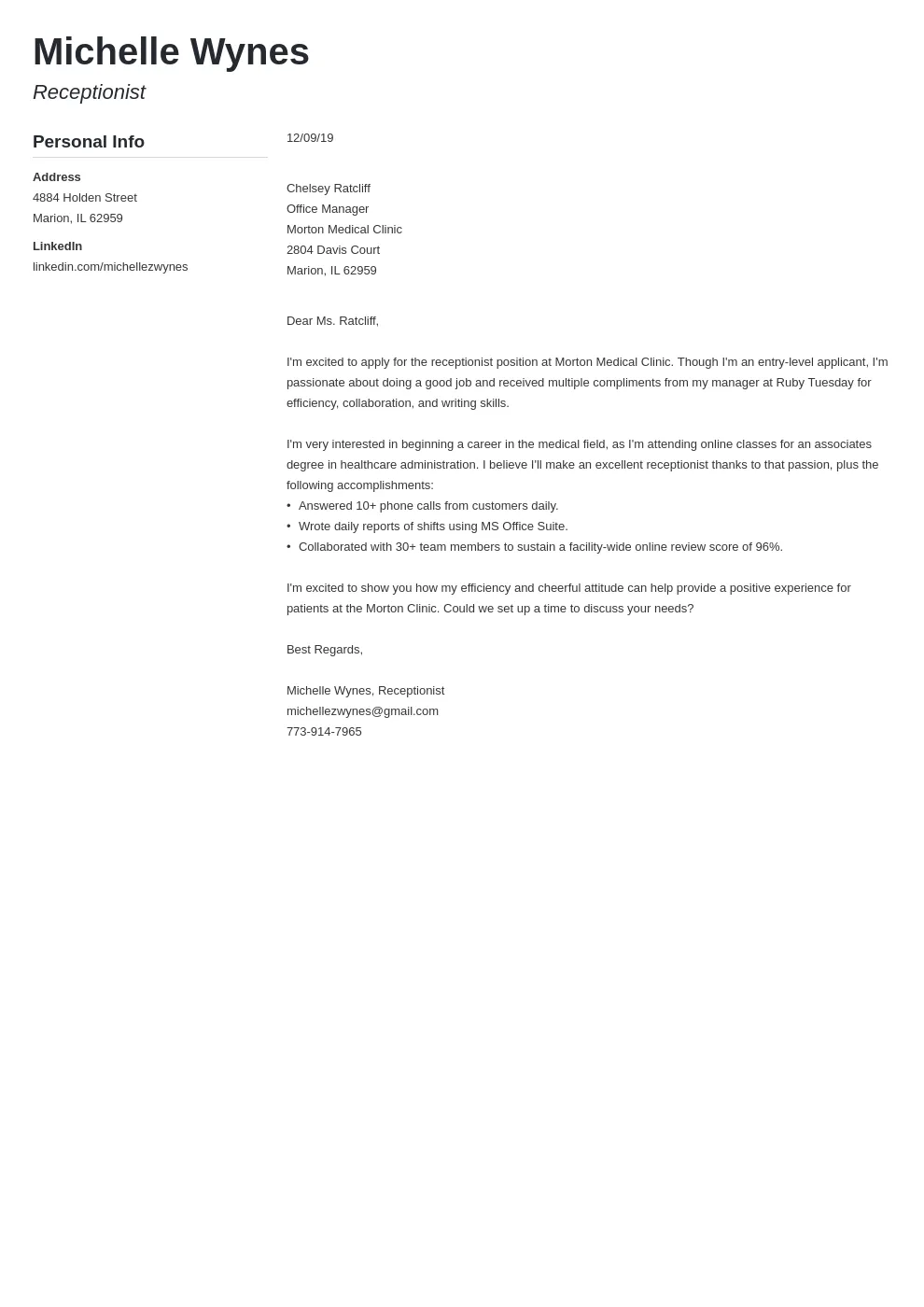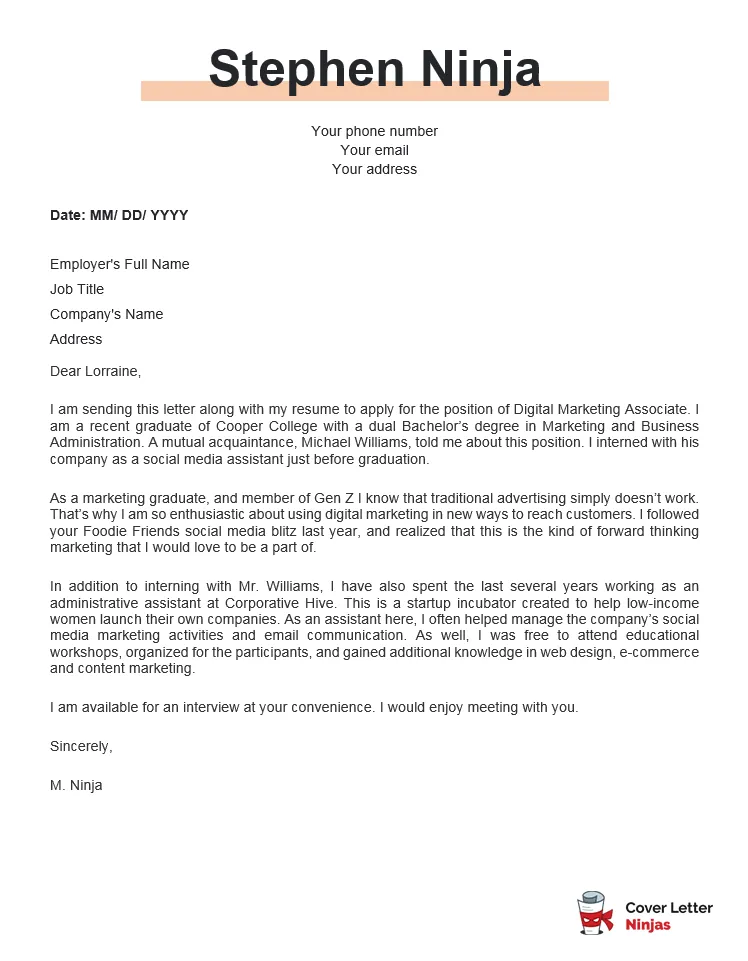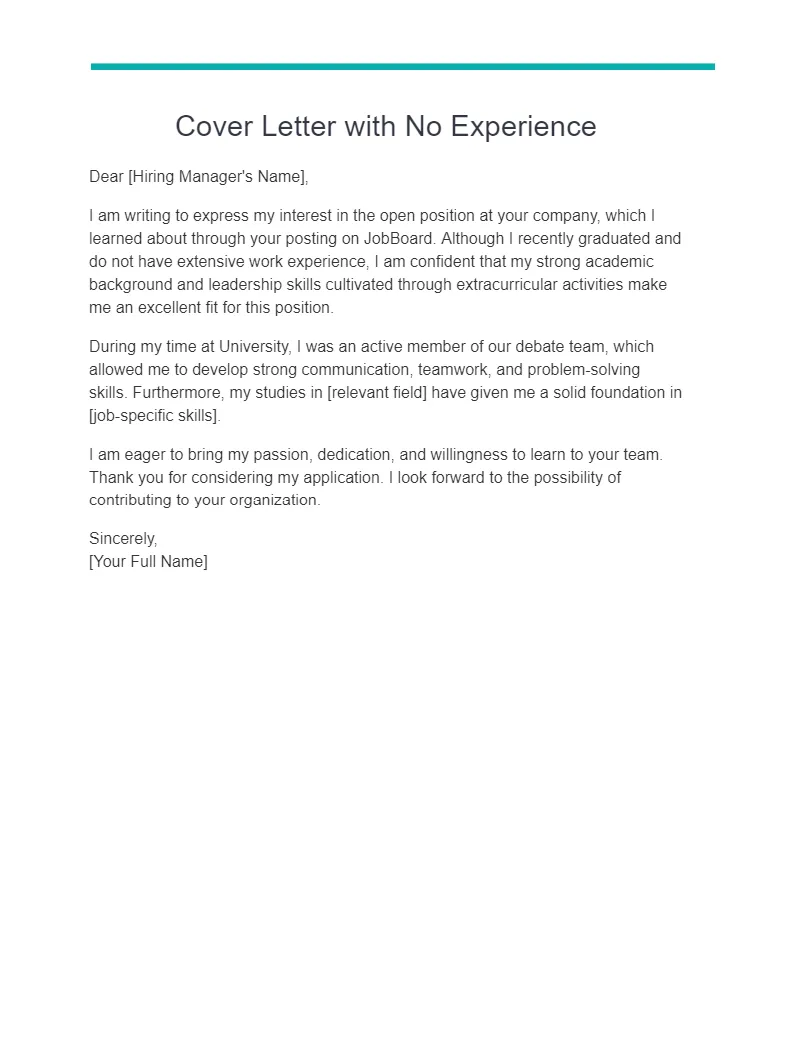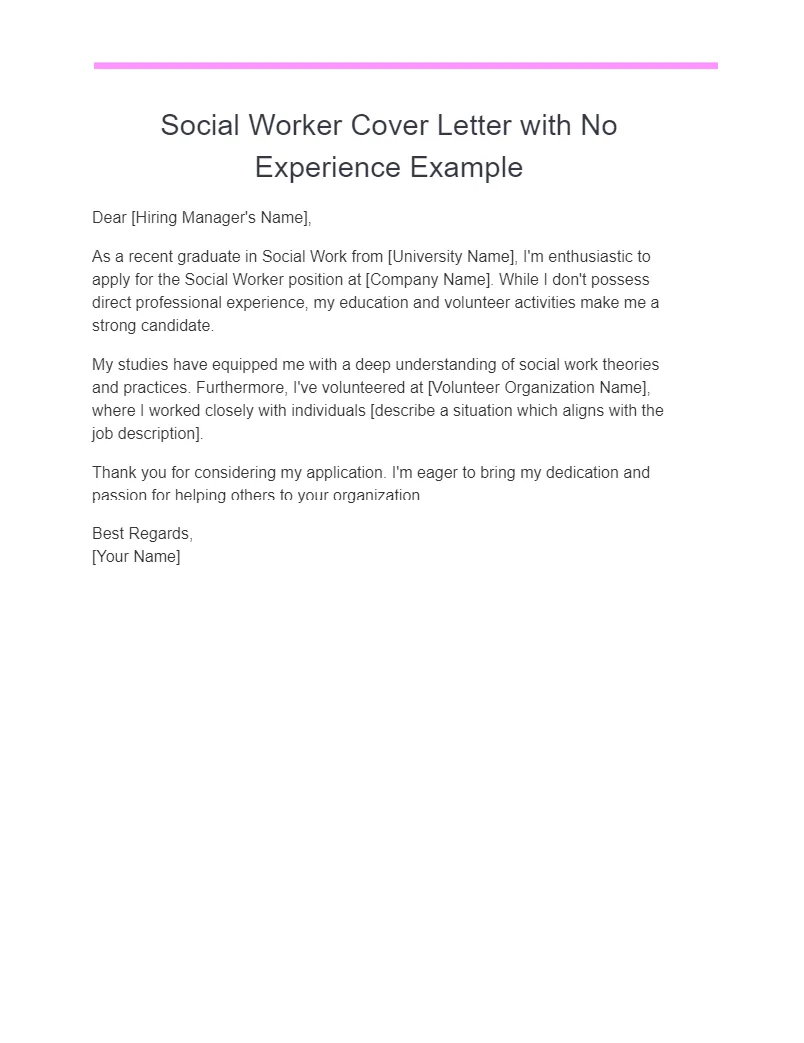Understanding the No-Experience Cover Letter
Writing a cover letter with no work experience can seem daunting, but it’s a crucial step in your job application. The goal is to demonstrate your potential and suitability for the role, even without a traditional employment history. This type of cover letter allows you to highlight your skills, education, and any relevant experiences that showcase your capabilities. Unlike a resume, a cover letter gives you the space to tell your story, explain your career goals, and connect your skills to the employer’s needs. It is your first impression, a chance to make a positive and compelling statement to the hiring manager. Therefore, approach it as an opportunity to present yourself in the best possible light and stand out from other candidates, despite the lack of direct work experience. Remember that every detail in your cover letter should align with the requirements of the job you’re applying for.
Key Cover Letter Components
A well-structured cover letter is essential for capturing the reader’s attention and presenting your qualifications effectively. Your cover letter should follow a standard format to maintain professionalism and clarity. Start with a header that includes your contact information, the date, and the hiring manager’s contact details. Next, use a professional salutation, such as ‘Dear Mr./Ms. [Last Name],’ to address the recipient correctly. The body of the cover letter should consist of an engaging opening paragraph that explains why you are applying for the job. Then, the main body should emphasize your transferable skills, education, and relevant experiences. End with a strong closing paragraph, restating your interest and including a call to action, such as requesting an interview. Finally, close your cover letter with a formal sign-off, such as ‘Sincerely,’ followed by your full name.
Header and Contact Information

The header of your cover letter is the first thing the hiring manager will see, so it is crucial to make a good impression. Start by listing your full name, address, phone number, and email address. Make sure your email address is professional and easy to read. Below your contact information, add the date. Then, include the hiring manager’s name, title, and company address. Finding the hiring manager’s name through LinkedIn or the company website shows you have done your research and are paying attention to detail. This structured format ensures the recruiter can easily identify your contact information and the date of your application. Additionally, always make sure all the information in the header is up to date and accurate to ensure your application can be processed efficiently.
Addressing the Hiring Manager
Addressing the hiring manager correctly sets a professional tone and shows that you have taken the time to personalize your application. If you know the hiring manager’s name, use it. A personalized salutation like ‘Dear Mr./Ms. [Last Name],’ demonstrates that you have done your research and are paying attention to detail. When the hiring manager’s name is not available, it is best to use a general salutation such as ‘Dear Hiring Manager’ or ‘Dear [Department] Team.’ Avoid generic greetings, such as ‘To Whom It May Concern,’ as they make your cover letter seem less personal and less tailored to the specific role. Proper addressing shows that you are serious about the job and committed to presenting yourself professionally from the very beginning of the application process. When you have a name, use it, and double-check the spelling to avoid any embarrassing mistakes.
The Opening Paragraph
The opening paragraph should grab the hiring manager’s attention and make them want to read more. Start by stating the position you are applying for and where you found the job listing. This lets the hiring manager know the purpose of your letter immediately. Next, briefly mention what interests you about the company and the role. This shows that you have researched the company and understand their values and needs. Clearly state your enthusiasm for the opportunity and why you are a good fit, even without work experience. Emphasize your understanding of the job requirements and how your skills and experiences align with the position. The opening paragraph is your elevator pitch – it should be concise, engaging, and leave the reader eager to learn more about your qualifications and motivations. Your goal is to make a strong first impression that sets the tone for the rest of your cover letter.
Highlighting Skills and Abilities

Since you lack work experience, you must focus on your skills and abilities to demonstrate your potential. Think about the skills the employer is seeking and how your abilities match those requirements. Identify your key skills and provide specific examples of how you have used them. This could include examples from school projects, volunteer work, extracurricular activities, or personal projects. For each skill, give a brief example that showcases how you applied the skill and the positive outcome. This approach demonstrates your capabilities in a practical context. Quantify your achievements whenever possible to illustrate your impact. For example, state how you improved a process or exceeded expectations. This proactive approach allows you to present yourself as a valuable candidate, even without traditional work experience. Highlight your adaptability and willingness to learn and excel in the role.
Transferable Skills
Transferable skills are those skills that you have developed in various settings, such as academics, volunteer work, or personal projects, that are applicable to the job you are applying for. Identify your transferable skills and connect them to the job requirements. Highlight communication, problem-solving, leadership, teamwork, organization, and time management skills. Provide examples of how you have used these skills in the past. Describe a project where you demonstrated your teamwork skills or a situation where you successfully managed your time to meet a deadline. Showcase your versatility by showing how you used these skills in different environments. When you can show that you can take a problem, break it down, and resolve it efficiently, you increase your chances of getting a job. By emphasizing these skills and providing relevant examples, you can show potential employers how your abilities align with their needs, even without prior work experience.
Showcasing Volunteer Work and Projects
Volunteer work and projects offer valuable opportunities to gain experience and develop skills that are directly transferable to the professional world. Use your cover letter to detail your volunteer work and project experiences. Start by describing the organization or project, what your role was, and what you accomplished. Focus on the skills you gained and how you applied them. Quantify your achievements whenever possible. For example, state how you helped to increase the number of participants or how you improved efficiency. Describe the specific skills you developed, such as project management, communication, or problem-solving. Explain the challenges you faced and how you overcame them. Demonstrating initiative and a willingness to contribute is highly valued. By presenting your volunteer work and projects effectively, you show potential employers how your experiences have prepared you for the job. Showcasing such experiences proves that you have the skills and desire to contribute, even without traditional work experience.
Emphasizing Education

Education is a cornerstone of your qualifications when you lack work experience. Highlight your academic achievements and any relevant coursework. Include your degree, major, and any honors or awards you have received. Mention any projects, research, or coursework that aligns with the job requirements. Describe how your education has prepared you for the role. Emphasize any skills you gained, such as critical thinking, analytical skills, or problem-solving. If you have taken any relevant courses or participated in any special programs, be sure to include them. Explain how your education aligns with the job requirements, and showcase your academic accomplishments. Include any specific projects or research that you’ve conducted that are relevant to the job. This demonstrates your preparation and commitment to the field. By highlighting your education, you can demonstrate the skills, knowledge, and dedication that make you a strong candidate. This reinforces your potential and commitment to the role.
The Closing Paragraph
The closing paragraph is your last chance to make a positive impression, so summarize your main points. Reiterate your interest in the position and thank the hiring manager for their time and consideration. Mention again why you are a good fit for the role and the company. Reiterate the skills and experiences that make you an ideal candidate, even if you lack direct work experience. Emphasize your enthusiasm for the opportunity and your readiness to contribute to the company’s success. End your cover letter with a strong call to action. This will let the hiring manager know you are very interested in this position. A well-written closing paragraph reinforces your key qualifications and leaves a lasting impression. This confirms your suitability and enthusiasm, making the hiring manager more likely to consider your application further.
Call to Action
A call to action is an essential part of your closing paragraph and should clearly state what you want the hiring manager to do next. You should request an interview and express your availability. Make it easy for them to contact you by including your contact information. Thank the hiring manager for their time and consideration. Express your excitement about the opportunity and reiterate your interest in the role. Avoid being passive. Instead, make it clear that you are eager to discuss your qualifications further. Make the hiring manager aware that you are actively seeking the opportunity to be a valuable asset to their team. Use strong, confident language to express your enthusiasm and readiness to contribute. A well-defined call to action makes it easy for the hiring manager to take the next step, increasing your chances of getting an interview and landing the job.
Proofreading and Formatting

Proofreading and formatting are crucial for making a professional and polished impression. Carefully review your cover letter for grammar, spelling, punctuation, and clarity. Errors can undermine your credibility, so take the time to ensure your letter is error-free. Read your cover letter aloud to catch any awkward phrasing or mistakes. Check your grammar and spelling using a grammar checker like Grammarly or Microsoft Word. Pay attention to the formatting. Use a professional font, such as Arial, Calibri, or Times New Roman. Maintain consistent formatting throughout your cover letter. Use clear, concise language, and avoid jargon. Ensure that your letter is easy to read by using appropriate spacing and paragraph breaks. Make sure your cover letter is free of any errors and presented professionally. Proofread multiple times, and have someone else review it for a fresh perspective to make sure it is perfect.
Tailoring Your Cover Letter
Tailoring your cover letter to each job application is essential to demonstrating your genuine interest and qualifications. Customize your cover letter for each job you apply for. This includes mentioning the company and position you are applying for, and highlighting the skills and experiences most relevant to the specific role. The more specific you are to a role, the more the hiring manager will value you. Review the job description carefully and identify the key requirements. Then, showcase how your skills, education, and experiences meet those requirements. Use keywords from the job description to make your cover letter more appealing to the hiring manager. Research the company and tailor your cover letter to align with their values, mission, and culture. Showing that you understand the company’s needs and challenges can make you a more attractive candidate. Take the time to make each cover letter unique. Tailoring your cover letter shows you’ve taken the time to understand the role and the company, making you more likely to be selected for an interview.
